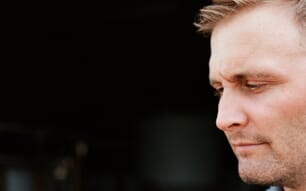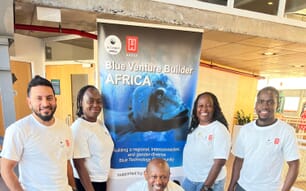Identity
Hypophthalmichthys molitrix Valenciennes, 1844 [Cyprinidae]
FAO Names: En - Silver carp, Fr - Carpe argentée, Es - Carpa plateada

Biological features
Body laterally compressed and deep. Ventral keel extending from isthmus to anus. Head large. Eye small, on ventral side of head. Gillrakers sponge-like. Dorsal fin with 8 rays; no adipose fin. Anal fin with 13 to 15 rays. Lateral line with 83 to 125 scales.
View SIDP Species fact sheet
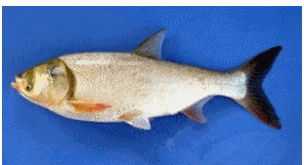
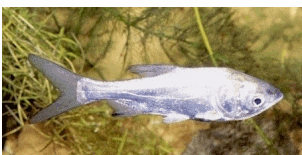
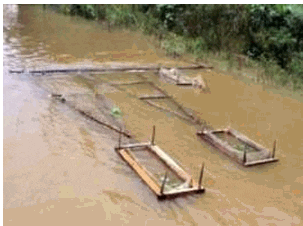
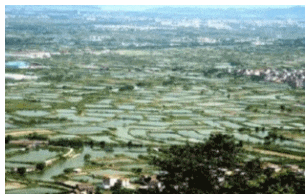
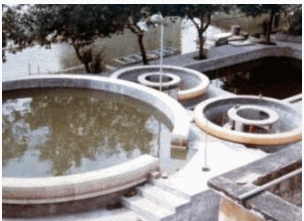
Profile
Historical background
In the 5th Century B.C. in China, Fan Li described the ponds used, the selection of fish, and the breeding season of common carp, together with its sex ratio and growth rate. By the Han Dynasty (3rd Century B.C. to 3rd Century A.D.), there were further developments in the production of common carp. In the Tan Dynasty (7th –10th Century) there was a transition period from common carp culture to the rearing of grass carp, black carp, silver carp and bighead carp. From the 10th to the 12th Century, expansion in the production of these four cyprinids was even greater, and the feeding habits and relationship between the species became better known. Subsequently, there has been great progress in pond-fish culture in China from the monoculture of common carp to the polyculture of grass carp, black carp, silver carp and bighead carp.
Since the 1950s, after a breakthrough in artificial breading, the culture of silver carp, as well as other carps, has spread tremendously into most areas of China. Silver carp has long been an important cultured species in China because:
- It is herbivorous and low in the food chain; feeds and fertilisers are therefore easily available at low cost.
- It can be polycultured with some other species, due to its specific habitat.
- Seeds are readily available from artificial breeding, without reliance on natural resources.
- Production management is simpler and the rearing period is shorter than for other carp species.
In recent decades, silver carp have been widely introduced into European and Israeli waters for algal control and as a food source.
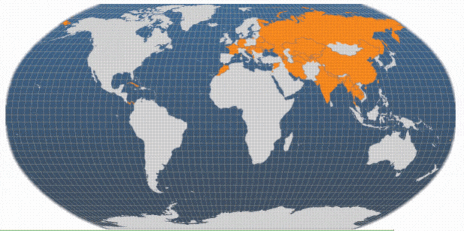
Habitat and biology
Silver carp is a freshwater species living in temperate conditions (6-28 °C) and its natural distribution is in Asia. This species requires static or slow-flowing water, as found in impoundments or the backwaters of large rivers. In its natural range, it is potamodromous, migrating upstream to breed; eggs and larvae float downstream to floodplain zones. While it is fundamentally benthopelagic, as an active species it swims just below the water surface and is well known for its habit of leaping clear of the water when disturbed.
Silver carp are typical planktivores, the gillrakers being the main means of filtration. Silver carp consume diatoms, dinoflagellates, chrysophytes, xanthophytes, some green algae and cyanobacteria ('blue green algae'). In addition, detritus, conglomerations of bacteria, rotifers and small crustaceans are other major components of their natural diet. Silver carp spawn in late spring and summer, when the temperature of the water is relatively high. From April to August, either because of the rainstorms or the swollen upper reaches of streams and rivers, its broodstock are concentrated in spawning locations where conditions are favourable, and the current swift, complicated and irregular. Spawning temperature is generally between 18 ºC and 30 ºC, with an optimum of 22-28 ºC.
The eggs of silver carp, like all Chinese carps, are non-adhesive. After spawning, the eggs begin to absorb water through the egg membrane and swell until its specific gravity is slightly greater than that of water, so they can stay at the bottom (in the case of static waters) or float halfway in mid-water (in flowing waters) until the fry hatch.
Production

Production systems
Seed supply
Broodstock
Good quality broodstock eligible for induced spawning are essential for seed production. Only when adults have reached 4 - 6 years old with a body weight of over 2.5 kg, as well being free from serious diseases and injuries, can they be acceptable for creating broodstock for induced spawning. Generally, broodstock are stocked by weight, at 1 500-2 250 kg/ha, with a female:male ratio of about 1:1.5.
Induced spawning Under artificial conditions, the pituitary glands of broodstock do not secrete sufficient hormone for their natural propagation in ponds. Artificial methods have been devised whereby such broodstock are injected with estrogenic agents such as LRH (Luteinizing Release Hormone) or LRH-A (Luteinizing Release Hormone-Analogue), fish pituitary gland (fish hypophysis), HCG (Human Chorionic Gonadotrophin), etc., so as to induce the fish to secrete its own gonadotrophic hormone, or to provide a direct substitute for this. The standard dose of the estrogenic agents varies:
- Fish hypophysis: 3-5 mg (DW)/kg of female broodstock (for male fish the dose is reduced by half).
- HCG: 800-1 000 I.U./kg of female broodstock.
- LRH-A: 10 µg/kg of female broodstock. The dose is given in two injections, 1-2 µg/kg in the first and the remainder in a subsequent injection after an interval of 12-24 hours. Only one injection is given to males, usually at the time of the second injection for females.
In order to facilitate production and operations, it is usual to ensure that the fish spawn in daytime. If the single injection method is adopted, it is given in the afternoon around 16.00; then oestrus will occur at about dawn on the following day and spawning will take place. If the double injection method is adopted, the first injection is most commonly given at 14.00-16.00 and the second at about 24.00.
Choosing the most suitable season to induce spawning is one of the key factors in the successful artificial propagation of silver carp. Other success factors include gonad maturity, suitable weather conditions and water temperature and local phenology. A period when average water temperatures remain at 18 ºC or more for 10-15 continuous days is considered an appropriate time for spawning induction.
Fry production
The environmental factors that affect hatching rate include a water temperature range of 22-28 ºC, with an optimum of 26 ºC. If it is lower than 17 ºC or higher than 31 ºC, embryonic development will cease, or be abnormal. After the emergence of the tail buds of the embryonic stage, oxygen consumption suddenly increases to more than twice of the amount of earlier stages. By the larval stage (68 hours after hatching) oxygen consumption reaches its highest peak, equivalent to 8-10 times that of the earlier stages. High dissolved oxygen levels are therefore highly important for the development of embryos and larvae.
Running water type hatching devices (hatching jars, vats and circular hatching tanks) are all designed in accordance with the characteristics of Chinese carp eggs and in order to fulfil the requirements of embryonic development. This enhances hatching rates and the availability of fry for stocking. Commonly, the volume of a hatching jar (vat) is about 250 l and the stocking rate is 2 000/litre. Circular hatching tanks are ring-shaped tanks built of cement or brick, with a size that depends on the scale of production. Small versions have a diameter of 3-4 m, while the larger type are 8 m in diameter. The rings are 60-100 cm wide and about 90 cm deep and the tanks may hold 7-15 tonnes of water. The stocking rate is in the range of 700 000-1 200 000 eggs/m³. Such tanks are suitable for comparatively large-scale production units.
Good water quality is very important to achieve a high hatching rate. Water that has been polluted by industrial activities or pesticides should not be used for hatching purposes. Small fish, tadpoles, shrimps and copepods are all very harmful to fish eggs and larvae. The degree of injury by predators is closely connected with egg density, the predator level, and the duration of contact with them. Predators may be eliminated by capture, filtration and chemicals such as quicklime, bleaching powder, rotenone etc.
Nursery
The culture of fingerlings requires special care because fry are small and delicate, their feeding ability is weak, they do not adapt well to changes in external environment, and they are not expert in avoiding predators. Therefore, well-controlled intensive systems are necessary to maximise survival rate and to produce healthy fingerlings that will lay a solid foundation for high productivity at the grow-out stage.
The nursery stage refers to the period from 3-4 day old fry to the production of fingerlings that can be stocked into the grow-out enclosures. There are two stages in nursery production. Firstly, in the fry rearing stage, they are grown until they are 15-20 days post-hatch and have a body length of 2.5-3 cm; these are usually called 'summer seedlings' in China. Secondly, in fingerling production, these 'summer seedlings' are reared for a further 3-5 months, when they become 8-12 cm in body length, which are known as 'yearlings'.
After draining the nursery ponds, mud and wastes need to be removed and dikes repaired, following which they must be sterilised with chemicals or herbs before the stocking of fry. The main purpose of these procedures is to eradicate predatory and other wild fish, harmful aquatic animals and plants, parasites and their eggs, and pathogenic bacteria. The chemicals used may be quicklime (CaO), bleaching powder, tea-seed cake, rotenone, etc.
After pond clearing, the pond water is fertilised by applying a basal manure, in order to produce natural food organisms before the fry are stocked. The time of application and the amount of manure vary with the pond conditions and the type of fertiliser. Fermented manure and compost, if used, may be applied within 3-5 days before fry are stocked, at 2 250-4 500 kg/ha. The water should look greenish brown, indicative of rich plankton population.
The fry stocking rate has an impact on survival rate. If it is too high, survival will be low; however, it should not be too low either, or space will not be properly utilised and production costs will be unnecessarily high. The correct stocking density is 1.5-2.25 million/ha.
The routine management of nursery ponds consists of:
- Morning and afternoon inspections to observe fry activity and changes in water colour, in order to decide on the quantity of fertiliser and food to apply, or whether water replacement is necessary.
- Being careful to exclude harmful insects, frog eggs and tadpoles, etc., and to remove the weeds growing at the edges of the ponds.
- Observation, so that fish diseases can be prevented or treatment given.
- Training the fry, so that they are strong enough withstand transfer into fingerling ponds with minimal mortality. This training process consists of driving the fry into a net-cage with a net and concentrating them in it for about 20-30 minutes, during which they secrete a lot of mucus and their muscles become stronger. Then they are released back into the pond. Usually, this process is carried out once or twice before the fry are transferred into fingerling ponds.
Ongrowing techniques
A two-year-culture cycle is generally adopted in pond fish culture in China; the first year is for rearing fry into fingerlings and the second year is for rearing fingerlings into market-size fish.
Polyculture is very popular in the rearing of silver carp in China. The considerable skill of aquaculturists enables them to maximise unit production efficiently by using the characteristics of various species to utilise the whole water body efficiently.
Another popular system is continuous harvesting and stocking, sometimes referred to as 'catching and stocking in rotation'. This consists of stocking at a high density, partial harvesting of the larger fish, and the addition of new fingerlings; this keeps the carrying capacity of the pond high all the time. This also speeds up turnover and supplies fresh fish to the market in both summer and autumn. Silver carp and bighead carp are the main species used in this system; grass carp and a small amount of Wuchang fish are the next most used. If tilapia is polycultured, market-sized fish should be netted out, leaving the smaller ones, in order to stop them propagating in the pond.
Feed supply
Silver carp are typical phytoplankton feeders, consuming diatoms, dinoflagellates (Pyrrophyta), golden brown algae (Chrysophyta), yellow green algae, some green algae and blue green algae (Cyanophyta). In addition, detritus, conglomerations of bacteria, and rotifers and small crustaceans are major components of their natural diet. Generally, there is no need to provide formulated feed in silver carp culture.
Harvesting techniques
In the continuous harvesting and stocking system the following aspects need care:
- Injuries and mortalities are liable to occur in summer and autumn harvesting if this operation is slow and careless, because water temperatures are rather high at that time and fish are active and consume a great deal of oxygen; they can not stand being herded together for long periods.
- Fish should be caught on cool days, when they are not gasping, never on humid or rainy days when the fish are gasping or likely to gasp. Feeding should be reduced the day before harvesting and wastes and grass residues that hamper harvesting operations removed.
- When the fish are confined, those that have not yet reached the marketable size must be returned to the ponds immediately and gently.
- Harvesting operations stir the pond bottom mud, resulting in turbidity and higher organic matter levels; fish also consume more oxygen after violent activity. It is therefore essential to replace a large amount of the water and to turn on aerators in order to increase the dissolved oxygen content.
Handling and processing
Silver carp are normally bought live, based on traditional consumption patterns in China. It is therefore essential to keep them alive from harvesting to marketing. Trucks and boats containing water are basically used as transportation tools in most areas.
Production costs
The production costs for silver carp vary from country to country (and even place to place) and the scale of operations. The major factors are the cost of labour, culture facilities, water, seed, feed (fertiliser), power, and transport.
Diseases and control measures
The major disease problems affecting silver carp are included in the table below:
| DISEASE | AGENT | TYPE | SYNDROME | MEASURES |
|---|---|---|---|---|
| Enteric Redmouth Disease | Yersinia ruckeri | Bacterium | Inflammation & erosion of jaw & isthmus; emaciation; darkening; red opercula; red fin bases; haemorrhages on intestine containing yellow fluid; stomach with clear fluid | Sulfamerazine or oxytetracycline baths |
| Bothriocephalus infestation | Bothriocephalus archeilognathi | Cestode tapeworm parasite | Infestation commonly occurs in the intestine; details not stated | No information available |
| Myxobolus infestation | Myxobolus pavlovskii | Myxosporean parasite | Occurs most commonly in gills; details not stated | No information available |
| Anchorworm Disease | Lernaea sp. | Copepod parasite | Wounds on the skin & muscular tissue | Trichlorfon or Diflubenzuron baths |
| Dactylogyrus Gill Flukes Disease | Dactylogyrus sp. | Monogenean parasite | Gills swollen & pale; high mucus secretion; spread opercula; restlessness near inflow; gasping air; heavy ventilation; dark colour; loss of weight; feeding ceases; high speed swimming; jumping; scraping against objects; can cause epithelial outgrowths & tissue swelling on gills; serious epizootics & mortality | Masoten, quinine, Trichlorfon, formaldehyde, methylene blue, Flubendazole, Mebendazole, Levamisole, or Praziquantel baths |
| Trichodinosis | Trichodina sp. | Protozoan parasite | Slime covers skin like fog, fins clamped & denuded of tissue | Formalin, malachite green or methylene blue |
Suppliers of pathology expertise
In China, advice is obtainable (for example) from:
- Prof. Wu Shuqing, Fish Pathologist, Pearl River Fisheries Research Institute, Chinese Academy of Fishery Sciences. (http://www.prfri.ac.cn/).
Statistics
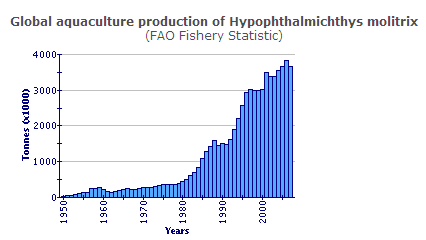
By far the largest producer of silver carp through aquaculture is China, while India and Bangladesh are also major producers of this species. Significant amounts of silver carp are also raised in Iran, the Russian Federation and Cuba.
Market and trade
Hypophthalmichthys molitrix is generally cultured and consumed locally alive or fresh in most of the producing countries. No information is available on international trade. The market price in China for this species is relatively low compared to most other species, normally 4-5 Yuan/kg (USD 0.5/kg). There are no specific market regulations for silver carp; it is treated the same as most fish commodities in the markets.
Status and trends
Hypophthalmichthys molitrix is a native species in China and Eastern Siberia, but has been introduced to many other countries for aquaculture and its use in controlling algal blooms. It is not only utilised as human food but also appreciated by its ability to clean reservoirs and other waters from clogging algae.
The culture of silver carp has expanded steadily over the past decade, rising from 1.9 million tonnes in 1993 to 4.1 million tonnes in 2003. Further expansion is expected as its production costs are lower than most other cultured species since there is no need to provide supplementary formulated feed, and most ordinary people can afford to consume it regularly.
Recent research on silver carp is mainly focussed on integrated fish farming in small-scale aquaculture in developing countries.
In order to keep the product longer and further extend the markets instead of just consuming it fresh, processing technologies need to be developed.
Main issues
Hypophthalmichthys molitrix is traditionally sold fresh for human consumption and has also been introduced into many countries where its ability to clean reservoirs and other waters of clogging algae is appreciated even more than its food value. However, several countries have reported adverse ecological impacts following its introduction. The main global issues currently are:
- If silver carp are introduced into the wild, it is anticipated that they will quickly and extensively establish themselves.
- Silver carp can consume two or three times their weight of plankton each day. Because of their preferred food items, they may provide direct competition with native fish larvae and juveniles.
- Silver carp can grow about 1 m in length and about 27 kg in weight and can represent a danger in public waters used for recreation. It has been reported that boat, jet skiers and fishery biologists have all been hit by silver carp in the lower Upper Mississippi River, for example.
Responsible aquaculture practices
Silver carp production, since no supplementary feed is supplied, is a rather environmentally friendly way of animal protein production. Responsible aquaculture at the production level should be practised in accordance with the main principles of environmental and ecological protection, as laid out in Article 9 of the FAO Code of Conduct for Responsible Fisheries.
March 2010



